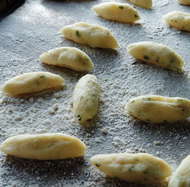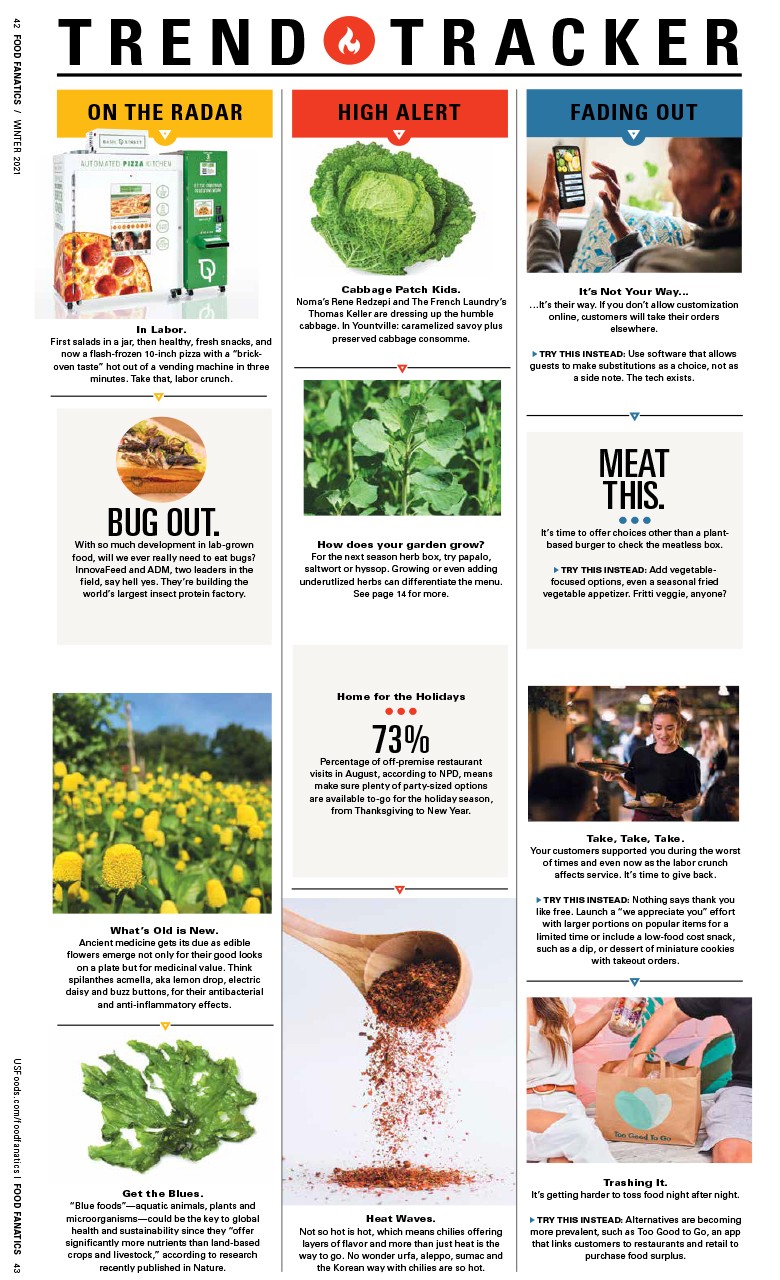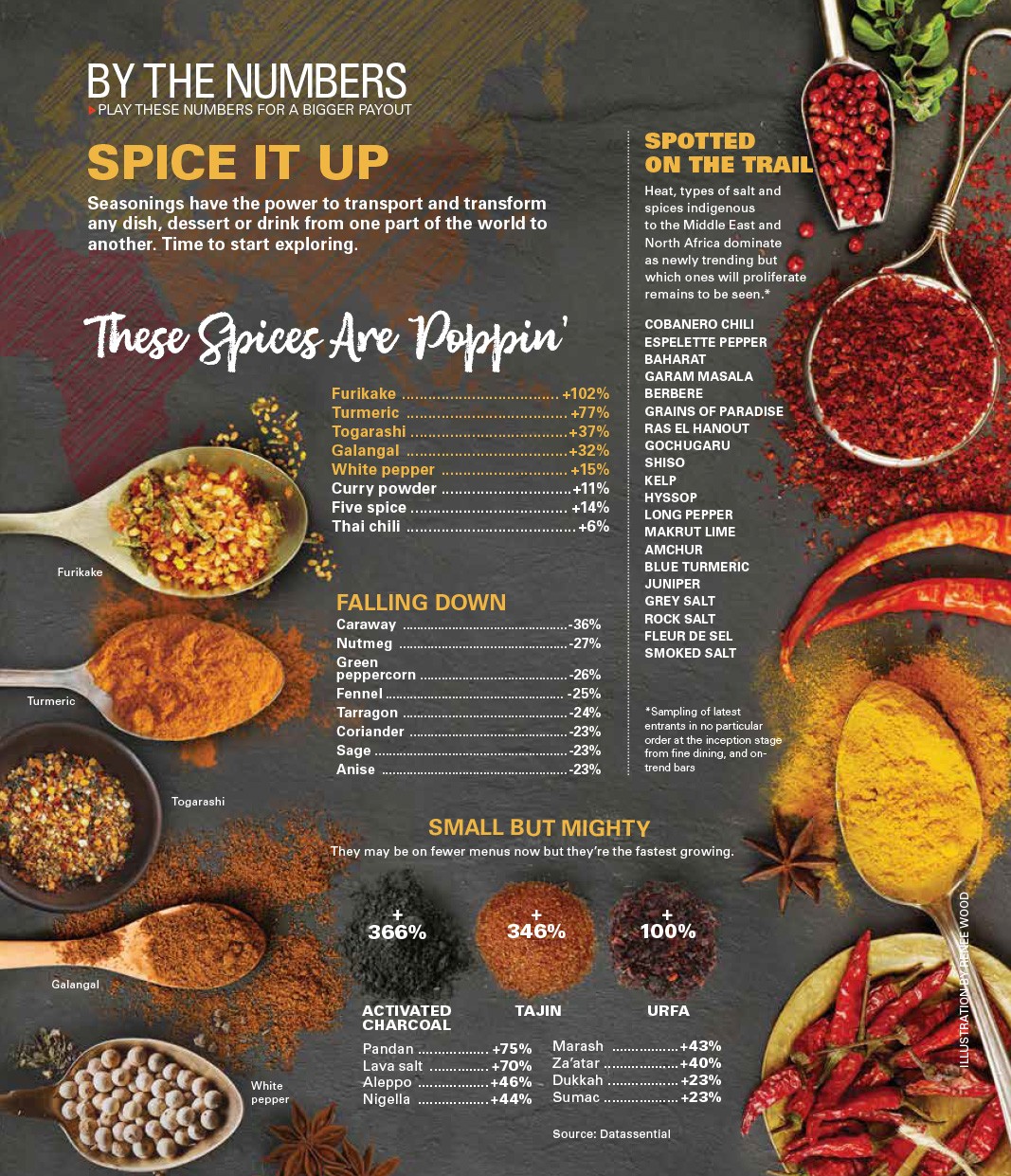RESTAURANTS ARE WINNING WITH GERMAN CUISINE
Sauerkraut and pickles, craft beer, housemade sausages and Old World breads are the hallmarks of the artisanal movement. They make up the backbone of German cuisine, yet Germany has not been given the culinary star treatment like France, Italy, Spain and Scandinavia.
Some signs, though, indicate that German cuisine is starting to find a foothold. The most well-known German dish, sauerkraut, is found on more than 10 percent of menus in America, according to foodservice research firm Datassential. While spaetzle appears on only 5.4 percent of fine dining offerings, it has risen nearly 30 percent since 2010 on overall menus.
“As chefs, we’re always looking for the next exciting cuisine that we can pilfer for our own purposes,” says Executive Chef Andrew Zimmerman of Sepia in Chicago. “That’s how we get to Germany. Obviously they have good food. Germany is one of the great sausage-making countries of the world. It’s funny that it took us this long to get there.”
Recognizing the potential, some chefs, like Zimmerman, are adding German-accented dishes to their menus. Others are going all-out Teutonic, opening German-centric restaurants. By avoiding—or adapting—beer hall cliches to appeal to contemporary American diners, these chefs are giving German food what it has rarely received before: a platform to showcase culinary depth.
“German food has been pinned to sausage and beer, and this is an important part of my restaurant,” says Chef-owner Tim Wiechmann of Bronwyn, a restaurant focused on the foods of Central Europe, in Somerville, Massachusetts. “But it is not everything.”
PLAYING WITH GERMAN DOUGH DISHESChicago’s Table, Donkey and Stick is an Alpine concept, which means Executive Chef Scott Manley draws ideas from all over Central Europe, including pasta. But instead of pasta, he makes dumplings such as bubespitzle (also known as schupfnudeln) and maultaschen. Manley likens bubespitzle to gnocchi, though longer and with tapered ends. He poaches and pan-fries them. Likewise, maultaschen takes the place of ravioli. The filling includes breadcrumbs, eggs and meat, like a meatball, which is spread onto the inner layer of pasta. Manley rolls it up and cuts it into pinwheels, leaving the filling exposed rather than pinching the edges closed. “It’s like a ravioli that is filled with a dumpling and crossed with a strudel,” he says. |
DEFINING NEW GERMAN CUSINE
Philadelphia’s Brauhaus Schmitz opened in 2009 with a menu that customers expected to see in a beer hall, specifically jägerschnitzel (meat with brown mushroom sauce) and sausage. To avoid a schnitzel-and-sausage rut, Executive Chef Jeremy Nolen began revamping less-common German dishes and serving them as Wednesday specials.
The dishes sold out so often that they became part of the menu and the inspiration behind “New German Cooking,” the book Nolen wrote with his wife and Brauhaus Schmitz’s pastry chef, Jessica. “Part of it is freshening up German-inspired cooking based on traditional ingredients,” he says.
In other words, making food lighter. Dandelion greens form the base of salads, while celery root—an ingredient more popular in Germany than celery—and other root vegetables are leveraged in sides, soups and salads.
The other part of new German, Nolen says, is revitalizing interest in regional dishes, such as schupfnudeln, a quark cheese, potato and herb dumpling; and spiessbraten, a spit-roasted pork preparation—though Nolen uses flank steak.
FLAVORS OF GERMAN COOKING
“I’ve been to dozens of German restaurants in the U.S. and have never seen it (spiessbraten) on the menu,” he says.
To achieve German sensibility, chefs can rely on techniques such as fermenting, curing and smoking. “Sometimes a dish doesn’t read German, but it’s how the menu flavor profile makes it German,” explains Nathan Sears, chef-partner of The Radler, a modern German restaurant in Chicago.
For example, Sears cures meats for three days before cooking. Several untraditional ingredients are smoked, too, including créme fraîche, which he folds into sauces and kohlrabi slaw. Sears also mines produce, often turning to cucumbers and asparagus when composing starters and sides.
At Bronwyn, Wiechmann limits his pantry to represent Central Europe. “There is no balsamic vinegar in the building,” he says. Instead of olive oil, he maintains a fryer filled with pork fat. And his spice pantry is streamlined with essentials such as caraway, juniper, cloves, curry and coriander.
Beer is also an important ingredient. For haxe, beer-braised pork shanks, Wiechmann marinates the shanks in German lager for a few days to tenderize the meat. He then braises the shanks in the beer until tender, and serves with sauerkraut, potatoes and roasted apples. “The easy part of German food is that it’s easy to sell German beer,” Wiechmann says.
Zimmerman ranks sausage with sauerkraut and mustard among the world’s most perfect foods. “It’s right up there with a late-night taco or a slice of pizza,” he says.
MODERN GERMAN CUISINE PORTIONS
"As chefs, we're always looking for the next exciting cuisine that we can pilfer for our own purposes. That's how we get to Germany."
-Executive Chef Andrew Zimmerman of Sepia
To elevate sausage and sauerkraut for his menu, he turned to choucroute garnie, a braised sausage, pork and sauerkraut dish from the French-German border. But the traditional dish is hefty and hard to serve in a fine dining restaurant.
To scale back on portion size, Zimmerman uses duck instead of pork. “Duck is the next most versatile animal,” he says, explaining that he can serve every cut of the animal and use the fat for cooking. “It’s a nose-to-tail animal in the way a pig is,” he says.
He confits the gizzards and makes smoked duck sausage seasoned with wine, garlic, coriander and caraway, using lamb casings in place of pig casings. Medium-rare duck breast and red cabbage sauerkraut accompany the sausage and gizzards.
“For us, it’s about portioning,” Zimmerman explains. “And we opt for a little brighter acidity to balance it and cut the richness.”
GERMAN DISHES TELL A STORYGermany’s southwestern area of Idar-Oberstein is known for spiessbraten, a regional specialty of spit-roasted pork. Gem prospectors, who had traveled to South America in the 1800s, learned the cooking technique from gauchos and brought the Argentinian method back home. |
Fishing for Compliments
With a coast lining the North and Baltic Seas, Northern Germany has a long history of seafood consumption. Yet many chefs running German restaurants in America say fish can be an impossible sell. At The Radler, Sears finds diners even resist scallops. “What restaurant can’t sell scallops?” he asks.
Instead of taking seafood off the menu, Sears looks for fish he can order in smaller quantities, such as two pounds of whitefish yielding six orders. He’s hoping diners will eventually take the bait.
Surprisingly, German-themed seafood dishes are killing it at some non-German restaurants. At Oceana, a seafood restaurant in New York, Executive Chef Ben Pollinger worked with his sous chefs to create a seafood version of a German schlachtplatte, a plate similar to choucroute garnie. Intended to be a one-month special for Oktoberfest, it ended up staying on the menu for months. “This was the sleeper hit of the menu,” he says.
To pair with housemade sauerkraut, Pollinger makes bacon from swordfish, bratwurst from salmon, and weisswurst from monkfish and dorade. Fish skin ground with the fish meat melts into the sausages when cooked, adding richness, while pickled mackerel brightens the plate.
“My cooks love it because it gives them the opportunity to do something very artisanal,” he says. “They are making sauerkraut, curing and smoking bacon, making sausages and pickling fish. This is as Old World as it gets.”
Kate Leahy is an Oakland, California-based writer and cookbook author. Follow her on Twitter @KateLeahy.




